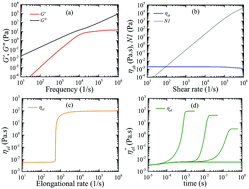How viscoelastic is human blood plasma?
Abstract
Blood plasma has been considered a Newtonian fluid for decades. Recent experiments (Brust et al., Phys. Rev. Lett., 2013, 110) revealed that blood plasma has a pronounced viscoelastic behavior. This claim was based on purely elastic effects observed in the collapse of a thin plasma filament and the fast flow of plasma inside a contraction–expansion microchannel. However, due to the fact that plasma is a solution with very low viscosity, conventional rotational rheometers are not able to stretch the proteins effectively and thus, provide information about the viscoelastic properties of plasma. Using computational rheology and a molecular-based constitutive model, we predict accurately the rheological response of human blood plasma in strong extensional and constriction complex flows. The complete rheological characterization of plasma yields the first quantitative estimation of its viscoelastic properties in shear and extensional flows. We find that although plasma is characterized by a spectrum of ultra-short relaxation times (on the order of 10−3–10−5 s), its elastic nature dominates in flows that feature high shear and extensional rates, such as blood flow in microvessels. We show that plasma exhibits intense strain hardening when exposed to extensional deformations due to the stretch of the proteins in its bulk. In addition, using simple theoretical considerations we propose fibrinogen as the main candidate that attributes elasticity to plasma. These findings confirm that human blood plasma features bulk viscoelasticity and indicate that this non-Newtonian response should be seriously taken into consideration when examining whole blood flow.



 Please wait while we load your content...
Please wait while we load your content...